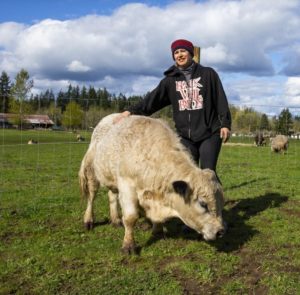This post a from Gwynne Mhuireach, who will be studying the microbiome of garden soils . . . and gardeners!!
***********
A little about me…

I am a researcher, farmer, and mom to twin teenagers. My formal education is broadly cross-disciplinary, including degrees in biology, architecture, and landscape architecture. While I was working on my Masters, I began studying microbes inside buildings as a member of the Biology and Built Environment Center at the University of Oregon, where we discovered that our exposure to microorganisms indoors depends a great deal on what microorganisms are present in the immediate outdoors. This line of inquiry was so fascinating that I entered the PhD program in Landscape Architecture to investigate how urban green space might influence the airborne microbial communities that people are exposed to in their daily lives. Ultimately with my research, I aim to gain a deeper understanding of how human health and environmental health are connected through the microbes we share.
In addition to my academic research, I also own and operate a small livestock farm with my two teenagers, Lyric and Cadence, and my partner, Tom. A native Oregonian, I was born and raised on a small farm near Klamath Falls, Oregon, where my family produced (and continues to produce) hay and cattle. Now I choose to continue the agricultural lifestyle that has been my family’s way of life for three generations. Producing food through hard work and stewarding a small piece of land to pass on to my children is very important to me. I believe that having a strong connection to the land is also part of what drives me to study microbes in the context of the outdoors, particularly how we interact intimately with them by getting our hands dirty in the soil.
The Garden(er) Microbiome Project
In partnership with Gail Langellotto, I am launching a new citizen science project called, “Microbes under your fingernails? An exploration of the garden microbiome and potential transferability to human skin.” While soil science is well-developed in terms of nutrients and organic matter needed to keep plants healthy, less is known about the diversity and composition of microbes present in agricultural soils, particularly in small-scale farms and gardens. Astonishingly, despite the likelihood of substantial exposure to soil microbes while gardening, yet we lack even the most basic understanding of how much microbial transfer from soil to skin occurs, what types of microorganisms are transferred, or how long they persist. Through this project, we seek to answer these questions with the help of volunteers—you!
Gardeners who volunteer to participate in this project will be asked to collect soil samples from several different beds in their gardens and from the surface of their hands and/or forearms. There will also be questionnaires that ask for information about garden management practices and daily skin care (use of anti-bacterial soap or lotion, etc.) during the sampling period, which will last 2 days. Volunteers will receive detailed results, including a comprehensive soil health assessment and skin/soil microbiome reports. We will also share our findings with other researchers, farmers/gardeners, and the broader public online and through the Master Gardener network. We anticipate that this citizen science project will not only answer our original research questions, but also shed light on how different management practices can impact garden soil health in different climate zones of Oregon.
If you are interested in participating in this project, I am hosting an informational webinar on Friday, June 5th (2020) at 10am. Registration is required to attend. The webinar will be recorded and posted.
If you are unable to attend, but are still interested in participating, please let us know a bit more about you and your garden by taking this short survey. Please note that for this particular project, we are specifically seeking gardens located in Oregon’s Willamette Valley or High Desert regions.


